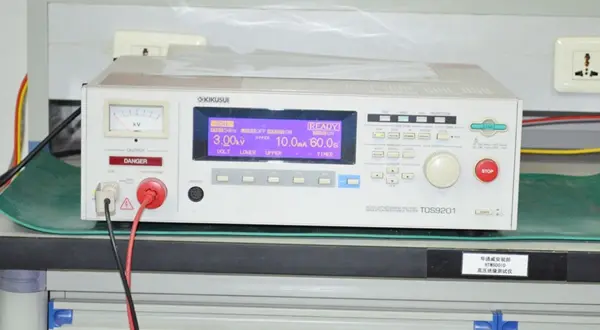
IEC 61326 EMC Testing for RF Lab Equipment
iec 61326-1outlines the immunity and emissions requirements for electrical equipment. As a leading authority in electromagnetic compatibility (EMC) and regULatory compliance testing, JJR LAB Complianceis committed to assisting electronics manufacturers in meeting a wide range of emc testing standards, including IEC and EN.
We not only understand the full testing process but also customize test plans based on client requirements to avoid unnecessary testing and REDuce costs. Contact us today for a quote and learn how we can help you achieve IEC 61326 RF equipment certification.

Applicable Equipment under IEC 61326
The standard applies to the following types of laboratory and industrial equipment:
1. Electrical equipment for measurement and testing
2. Control system devices
3. Electrical equipment intended for laboratory use
4. Accessories designed to be used with the above equipment
5. Equipment for both industrial and non-industrial environments
6. Computers, components, and IT equipment that meet applicable standards (additional testing may be waived)
Primary Application Scenarios
IEC 61326 addresses three main equipment environments:
1. Equipment intended for use in industrial locations
2. Equipment used in controlled electromagnetic environments (e.g., test laboratories)
3. Portable equipment, such as devices powered by batteries or test circuits
Types of EMC Interference
Equipment may be affected by various types of electromagnetic interference, including:
1. Conducted interference via power, measurement, or control lines
2. Radiated interference from the surrounding environment
3. Self-generated emissions conducted via cables or directly radiated
These disturbances can impact both the performance of the equipment and nearby systems.
Immunity Testing Requirements (Unintentional Radiators)
1. Input/output circuits using shielded cables may be exempt from conducted immunity tests between 150 kHz and 80 MHz.
2. Cables installed in conductive trays or conduits are also eligible for exemption.
3. Dedicated protective earth terminals are tested as AC power ports; functional earth connections are tested as I/O ports.
4. Higher immunity levels or system-level testing can be achieved through improved design or installation strategies.
Immunity Performance Criteria
1. Class A: Operates as specified with no degradation in performance
2. Class B: Temporary performance degradation or loss of function, but self-recoverable
3. Class C: Temporary loss of function requiring operator intervention to recover
4. Class D: Irrecoverable failure or loss of function, potentially resulting in data loss or permanent damage
Emissions Testing Requirements (Unintentional Radiators)
1. Testing is conducted in operating mode, as defined in the EMC test plan.
2. Emissions limits are categorized by equipment class:
a. Class A and B equipment share frequency bands: 30–230 MHz and 230–1000 MHz
b. Class B devices have stricter limits (30–37 dB) to minimize environmental impact, compared to Class A (40–47 dB)
JJR LAB Testing Capabilities & Advantages
1. Capable of testing fixed, mobile, and portable devices of various sizes
2. Comprehensive IEC 61326 series compliance testing
3. Environmental and packaging tests also available (e.g., temperature, vibration, accelerated aging)
4. State-of-the-art equipment and flexible scheduling ensure fast turnaround
Additional IEC 61326 Standards Supported by JJR LAB
1. IEC 61326-2-1: EMC testing for unprotected equipment, offering detailed configurations and performance criteria
2. IEC 61326-2-2: EMC requirements for equipment used in low-voltage power distribution systems, including battery-powered devices
3. IEC 61326-2-3: Covers transmitters with integrated or remote signal conditioning, designed for converting non-electrical inputs into process-relevant signals
4. IEC 61326-2-6: Specifies EMC requirements for in vitro diagnostic (IVD) medical equipment, with emphasis on its unique electromagnetic environment
Need expert EMC testing services?Contact JJR LAB today to request a quote and experience industry-leading compliance support.
Email:hello@jjrlab.com
Write your message here and send it to us
 Amazon ISO/IEC 17025 UL Testing Service Laboratory
Amazon ISO/IEC 17025 UL Testing Service Laboratory
 How to get CE Certification for Lighting Products?
How to get CE Certification for Lighting Products?
 CE Certification Standards & Process for Elect
CE Certification Standards & Process for Elect
 Japan METI Registration & Japanese Agent Servi
Japan METI Registration & Japanese Agent Servi
 Temperature Shock Test (IEC 60068-2-14:2009)
Temperature Shock Test (IEC 60068-2-14:2009)
 Electromagnetic Compatibility (EMC) Testing Servic
Electromagnetic Compatibility (EMC) Testing Servic
 Canada ISED Certification (IC Certification) Analy
Canada ISED Certification (IC Certification) Analy
 CSA C22.2 No.42 Compliance Test Report for Amazon
CSA C22.2 No.42 Compliance Test Report for Amazon
Leave us a message
24-hour online customer service at any time to respond, so that you worry!




